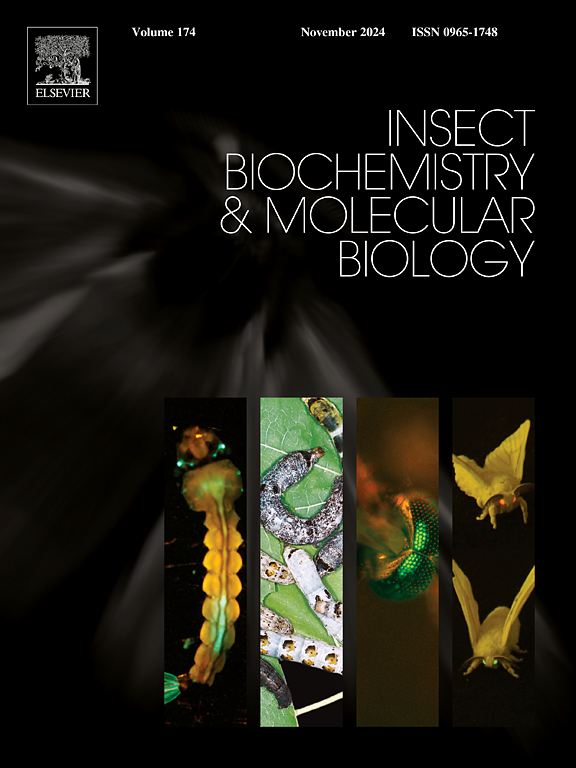A G-protein coupled receptor is involved in the DUOX pathway in Tribolium castaneum
IF 3.7
2区 农林科学
Q2 BIOCHEMISTRY & MOLECULAR BIOLOGY
引用次数: 0
Abstract
Activation of the dual oxidase (DUOX) pathway is an important intestinal defense mechanism against enteric infection triggering the formation of radical oxygen species by stimulating DUOX enzyme activity and/or gene expression. In insects, several studies have suggested that uracil released by pathogenic bacteria functions as a major trigger molecule for the activation of DUOX, which leads to the formation of antimicrobial hypochlorous acid (HOCl). While the recognition of pathogen-associated molecular patterns of microbes by pattern recognition receptors is well understood, the detection of uracil is still elusive. It has been postulated that a G-protein coupled receptor (GPCR) binds the pyrimidine uracil, which activates PLCβ signalling and further downstream events. So far, no pyrimidinergic receptor has been identified in insects, particularly none that binds uracil nucleotides or sugar derivatives. To identify potential candidates for insect pyrimidine receptors, we used a human P2Y4 receptor as a template to screen the Tribolium castaneum reference proteome. Four promising receptor candidates were identified, of which two were analyzed using RNA interference to determine their influence on uracil-induced TcDUOX expression, HOCl formation and development in control larvae and larvae that were challenged with the enteric pathogen Bacillus thuringiensis. Silencing TcGPCR41 resulted in a loss of uracil-induced TcDUOX expression and HOCl formation. Furthermore, the development of challenged larvae was affected in a manner like that observed in a TcDUOX knockdown. We conclude that the identified receptor may play a role in the uracil-dependent activation of the DUOX-pathways.

一种g蛋白偶联受体参与了木犀草DUOX通路
双氧化酶(DUOX)途径的激活是肠道防御肠道感染的重要机制,通过刺激DUOX酶活性和/或基因表达来触发自由基的形成。在昆虫中,一些研究表明,致病菌释放的尿嘧啶是激活DUOX的主要触发分子,DUOX导致抗菌次氯酸(HOCl)的形成。虽然模式识别受体对微生物病原体相关分子模式的识别已经很好理解,但尿嘧啶的检测仍然是难以捉摸的。据推测,g蛋白偶联受体(GPCR)结合嘧啶尿嘧啶,激活PLCβ信号传导和进一步的下游事件。到目前为止,还没有在昆虫中发现嘧啶能受体,特别是没有发现与尿嘧啶核苷酸或糖衍生物结合的受体。为了确定昆虫嘧啶受体的潜在候选物,我们使用人类P2Y4受体作为模板筛选了Tribolium castaneum参考蛋白质组。我们确定了4个有希望的受体候选体,并利用RNA干扰分析了其中2个受体对尿嘧啶诱导的TcDUOX表达、HOCl形成和发育的影响。沉默TcGPCR41导致尿嘧啶诱导的TcDUOX表达和HOCl形成缺失。此外,攻毒幼虫的发育受到了与TcDUOX敲除相似的影响。我们得出结论,鉴定的受体可能在尿嘧啶依赖性的duox通路激活中发挥作用。
本文章由计算机程序翻译,如有差异,请以英文原文为准。
求助全文
约1分钟内获得全文
求助全文
来源期刊
CiteScore
7.40
自引率
5.30%
发文量
105
审稿时长
40 days
期刊介绍:
This international journal publishes original contributions and mini-reviews in the fields of insect biochemistry and insect molecular biology. Main areas of interest are neurochemistry, hormone and pheromone biochemistry, enzymes and metabolism, hormone action and gene regulation, gene characterization and structure, pharmacology, immunology and cell and tissue culture. Papers on the biochemistry and molecular biology of other groups of arthropods are published if of general interest to the readership. Technique papers will be considered for publication if they significantly advance the field of insect biochemistry and molecular biology in the opinion of the Editors and Editorial Board.

 求助内容:
求助内容: 应助结果提醒方式:
应助结果提醒方式:


